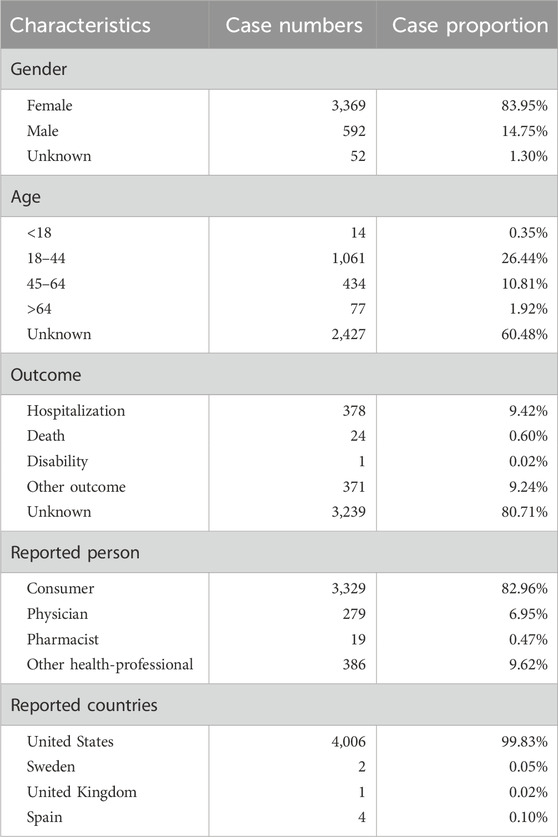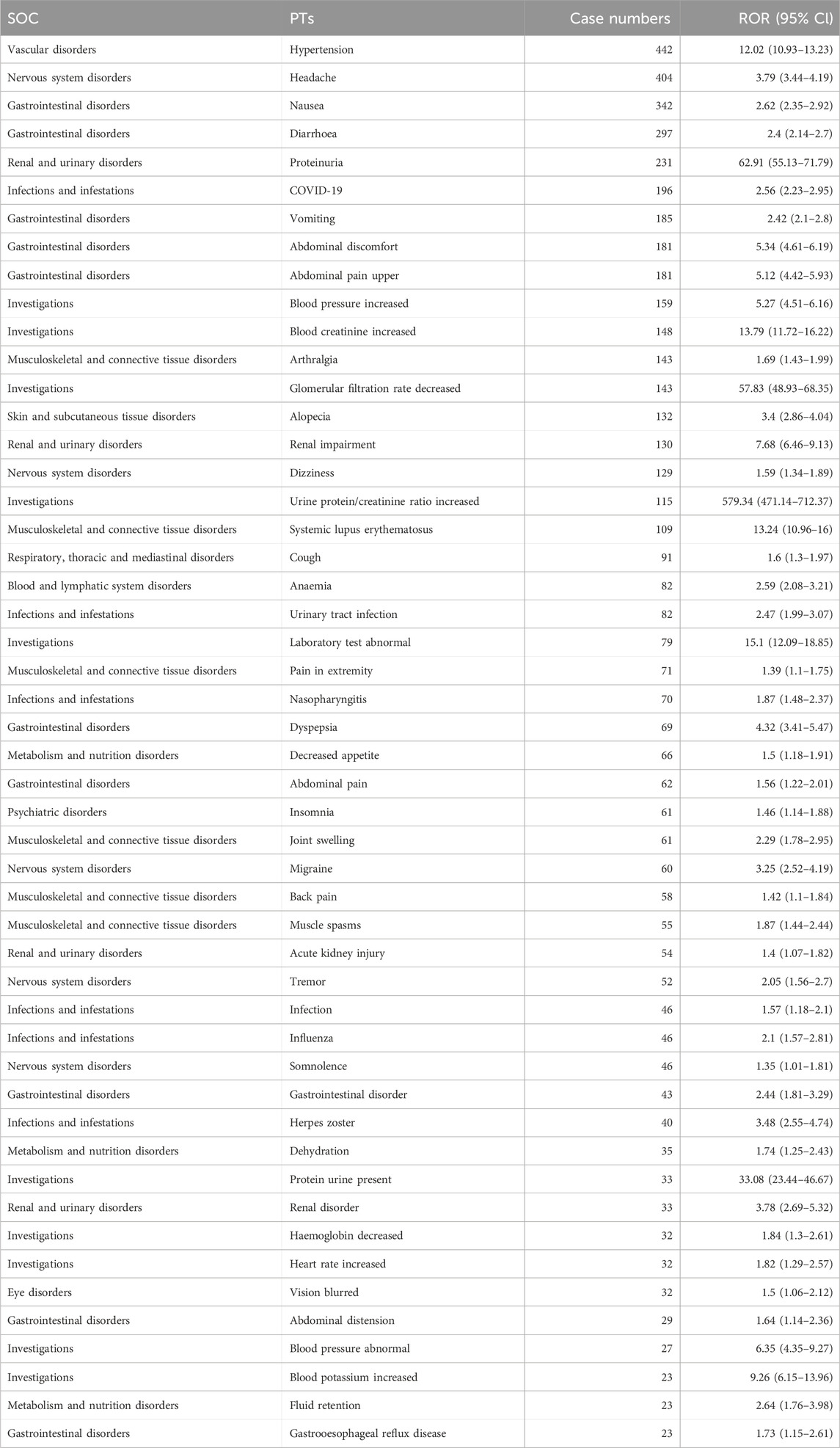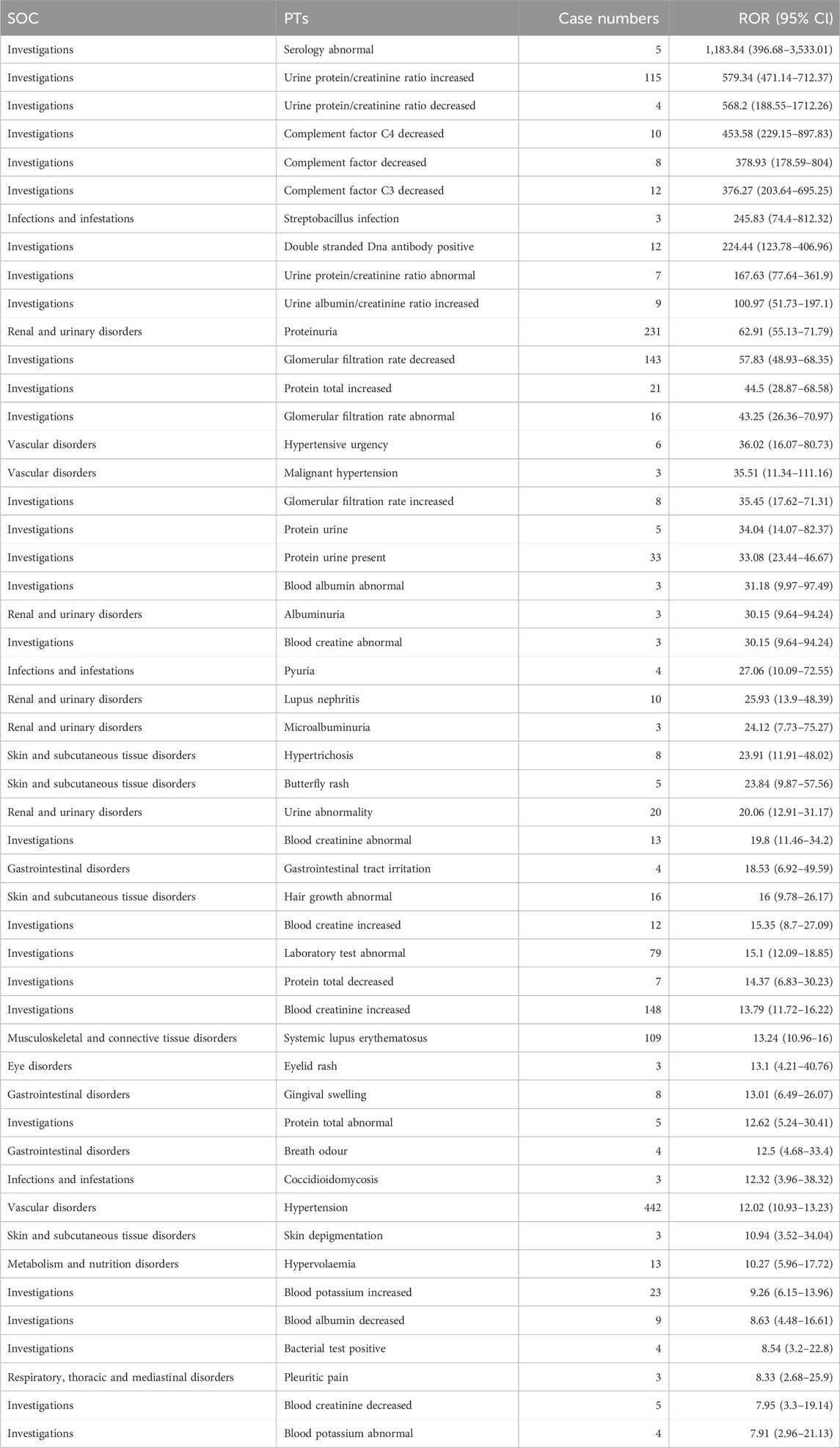- 1Department of Nephrology, The First Affiliated Hospital of Xiamen University, Xiamen, China
- 2Department of Public Health, The First Affiliated Hospital of Xiamen University, Xiamen, China
- 3Department of Nephrology, The Affiliated Qingdao Municipal Hospital of Qingdao University, Qingdao, China
- 4Department of Emergency, Qingdao Hospital, University of Health and Rehabilitation Sciences (Qingdao Municipal Hospital), Qingdao, China
Background: Voclosporin is a novel calcineurin inhibitor approved for the treatment of adult active lupus. Based on the US Food and Drug Administration Adverse Event Reporting System FDA Adverse Event Reporting System database, this study conducted a comprehensive evaluation of the safety characteristics of voclosporin in clinical use.
Methods: We selected data from the FAERS database from the 2021Q1 to 2024Q2. Disproportionality analysis was employed to detect positive signals at the System Organ Class (SOC) and Preferred Term (PT) levels. Our analysis encompassed the time to onset, and subgroup analyses stratified by gender and age.
Results: There are 3,407,094 reports collected from the FAERS database, of which 4,013 reports listed voclosporin as the “primary suspected” drug. Eight positive SOC signals and 138 positive PT signals were identified, including some unexpected signals that were not listed on the drug label such as menstrual disorder (n = 7, ROR = 5.82) and acute pulmonary oedema (n = 3, ROR = 4.16). Gender differences and age differences existed in PT signals related to voclosporin. Nearly one-third of the adverse events occurred within the first month after voclosporin initiation, with a median onset time of 99 days.
Conclusion: This study clarified the characteristics of voclosporin-related adverse drug reactions, providing strong support for clinical monitoring and risk identification of voclosporin.
Introduction
Lupus nephritis (LN) is the most common and severe complication of systemic lupus erythematosus (SLE), occurring in more than half of SLE patients (Zhou et al., 2018). The pathogenesis of LN includes aberrant activation of immune responses, autoantibody production, and immune mediated renal injury (Obrişcă et al., 2021a). Typically, LN occurs within the first 5 years of the onset of SLE, presenting from asymptomatic proteinuria or hematuria to clinically apparent nephrotic syndrome. Up to 20% of patients eventually progressed to end-stage renal disease (Anders et al., 2020). Steroids, cyclophosphamide, azathioprine, and mycophenolate mofetil remain the current first-line treatment for LN (Lech and Anders, 2013). These non-selective immunosuppressants have significantly improved patient and renal survival in LN (Moroni et al., 2018; Croca et al., 2011). However, there remains a substantial treatment-related morbidity and mortality, which has prompted the development of new therapeutic approaches targeting specific leukocyte subpopulations, such as anti-CD20 antibodies, proteasome inhibitors, and calcineurin inhibitors (CNIs) (Obrişcă et al., 2021b; Yung et al., 2020).
Voclosporin, a novel CNI, has been developed for the treatment of LN. The structure of voclosporin is similar to cyclosporine (CsA), containing a single amino acid substitution. Compared to other CNI, voclosporin exhibited enhanced efficacy, metabolic stability, and safety (Kale et al., 2023). The rationale for treating LN with voclosporin involved preventing excessive immune responses by inhibiting the activation of T cells. Additionally, voclosporin stabilizes the podocyte cytoskeleton, reducing proteinuria and attenuating renal damage in lupus patients (Rafael-Vidal et al., 2021). In the AURA-LV and AURORA 1 randomized controlled trials, voclosporin demonstrated superiority in achieving a complete renal response compared to standard care and received FDA approval in January 2021 as the first oral therapy for LN. Despite improved tolerability over traditional CNIs, voclosporin-related adverse drug reactions (ADRs) were still non negligible, including decreased estimated glomerular filtration rate (eGFR), hypertension, and headaches (Rovin et al., 2019; Rovin et al., 2021). Moreover, voclosporin has a black box warning for potential malignancies and serious infections risk, which may be fatal. Therefore, there is a crucial need to utilize real-world data to identify voclosporin safety signals (Lupkynis, 2021).
Materials and methods
Data sources and processing
The data for this study was downloaded from the FAERS database (Bihan et al., 2020), which serves as the primary system for post-marketing surveillance of adverse drug reactions in the United States and is a key avenue for current pharmacovigilance research. “Voclosporin” and its trade name “LUPKYNIS” were used as keywords for drug retrieval. In the FAERS database, drug-event relationships are classified into four categories: primary suspect, secondary suspect, concomitant, and interacting. To enhance the reliability of the analysis, only reports in which voclosporin was designated as the primary suspect (PS) were retained. Ultimately, we extracted adverse drug reactions related to voclosporin spanning from 2021Q1 to 2024Q2. Following FDA suggestions, we selected the most recent FDA_DT with the same PRIMARYID, and when FDA_DT and CASEID were identical, we chose the higher PRIMARYID to eliminate duplicates prior to data analysis. The collected data included demographic information, drugs, therapies, indications, reactions, and outcomes from the adverse reaction reports. We employed the “Medical Dictionary for Regulatory Activities” (MedDRA) to standardize adverse events terms in the Preferred Term (PT) format, subsequently classifying PTs by their respective System Organ Classes (SOCs).
Statistical analysis
We employed reporting odds ratio (ROR) to investigate the associations between voclosporin and adverse events (AEs). The calculation of the ROR algorithm was based on a 2 × 2 columnar table, with the detailed algorithm presented in Supplementary Table S1. If the lower limit of 95% CI exceeded 1.0 with at least three AE reports, the ROR is a positive signal. Higher ROR values indicated stronger signal intensity, signifying a stronger association between the target drug and the specific AE.
Subgroup analysis
To identify gender-specific and age-specific risks of ADRs, the ROR was utilized to detect disproportional signals among different subgroups following voclosporin administration, as described previously (Zou et al., 2024). The stratification was specifically into males and females, as well as adults aged 18–64 and the elderly aged 65 and above.
Time to onset analysis
The time to onset of ADEs caused by voclosporin were defined as the interval between the reported ADEs onset date and the start date of voclosporin administration. This study initially assessed the overall time to ADRs following voclosporin use. Subsequently, based on the results of the disproportionality analysis, the onset times of SOC levels and PT levels were assessed. We summarized the onset times of AEs using the median, interquartile range (IQR), and applied the Kruskal-Wallis test to evaluate whether there were significant differences in the onset times between different SOCs or different PTs.
The statistical significance was set at p < 0.05 for all analyses. All statistical analyses were performed using GraphPad Prism 10 (GraphPad Software, CA, USA) and R 4.3.3.
Result
General characteristics
From 2021Q1 to 2024Q2, a total of 3,407,094 case reports were obtained from the FAERS database. There were 4,013 case reports associated with voclosporin as the PS. Of these, AE reports from female accounted for 84.0%, significantly higher than those from males at 14.8%. According to the available age data, the most reports (26.4%) were in the age group of 18–44 years followed closely by 44–64 years (10.8%). The principal source of reports was the United States, contributing 4,006 reports (99.8%), and were generally reported by consumers (n = 3,329, 83.00%). Among the reported outcomes, hospitalization (n = 379, 9.4%) was the most common severe outcome (Table 1).
System organ class signals
As shown in Figure 1, the AEs resulted from voclosporin usage impacted 27 SOCs. Among these, eight noteworthy SOCs emerged, meeting ROR algorithms, including gastrointestinal disorders (n = 1737, ROR = 2.03), investigations (n = 1,338, ROR = 2.07), nervous system disorders (n = 950, ROR = 1.12), infections and infestations (n = 835, ROR = 1.27), musculoskeletal and connective tissue disorders (n = 692, ROR = 1.15), renal and urinary disorders (n = 638, ROR = 2.86), surgical and medical procedures (n = 598, ROR = 3.66), vascular disorders (n = 544, ROR = 2.57).
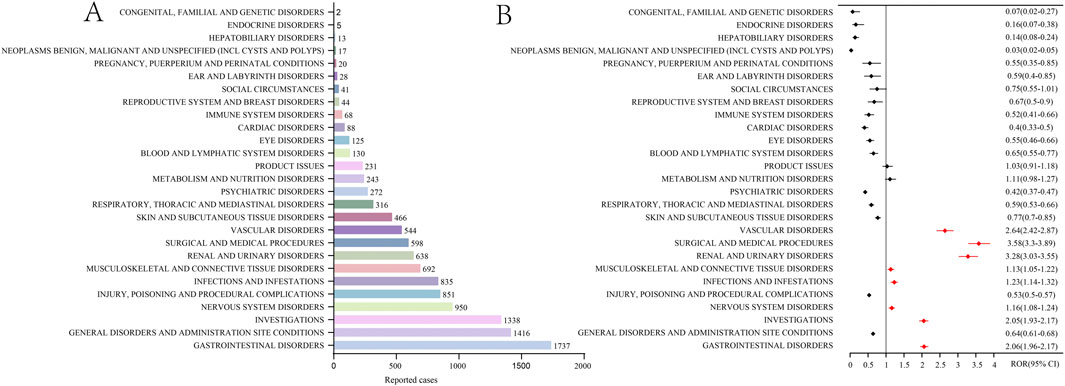
Figure 1. Signals detection at the SOC level. (A) The number of adverse events at the SOC level. (B) The results of disproportionality analysis based on the ROR algorithm at the SOC level. TheROR values and their 95% confidence intervals (95% CI) are visualized. SOCs with positive signals identified by the ROR algorithm are highlighted in red for clarity.
Preferred terms signals
The AEs associated with voclosporin encompassed 138 PT signals (Supplementary Table S2). To more accurately assess AEs directly related to voclosporin use, this study excluded AEs that could be attributed to drug characteristics or non-pharmacological factors, such as “injury, poisoning and procedural complications” and “product issues.” Tables 2, 3 list the top 50 PTs based on occurrence frequency and ROR values. Common AEs included hypertension (n = 442, ROR = 12.05), headache (n = 404, ROR = 3.79), nausea (n = 342, ROR = 2.62), diarrhea (n = 297, ROR = 2.4), and proteinuria (n = 231, ROR = 62.91), while AEs with higher ROR values primarily involved abnormalities in various investigations results. Most AEs were consistent with the results of clinical trials and the drug instruction. Notably, several unexpected AEs were also identified, including breath odour (n = 4, ROR = 12.5), menstrual disorder (n = 7, ROR = 5.82), acute pulmonary oedema (n = 3, ROR = 4.16), gastrooesophageal reflux disease (n = 23, ROR = 1.73), vision blurred (n = 32, ROR = 1.5), and insomnia (n = 61, ROR = 1.46), which had not been previously reported. Moreover, other AEs listed in the voclosporin package insert, such as malignancies, QT prolongation, and pure red cell aplasia, did not meet the criteria for positive signal.
Subgroup analysis of signals for preferred terms
To analyze the gender differences in safety signals of voclosporin, we employed the ROR algorithm to screen voclosporin-related AEs separately for males and females. In males, we identified 46 AEs (Supplementary Table S3), while in females, 122 AEs were identified (Supplementary Table S4). Comparing the AEs of different genders, we can find that 38 AEs can be observed in both male and female, while certain AEs were gender-specific. The top five AEs exclusive to females were nausea, dizziness, cough, urinary tract infection, and decreased appetite. The top five AEs exclusive to males were back pain, muscle spasms, vision impairment, neck pain, and dry mouth. Among the AEs common to both sexes, alopecia, headache, upper abdominal pain, and vomiting were more strongly associated with females, whereas gout, abnormal serum creatinine levels, elevated serum uric acid, and renal function abnormalities were more strongly associated with males (Figure 2A).
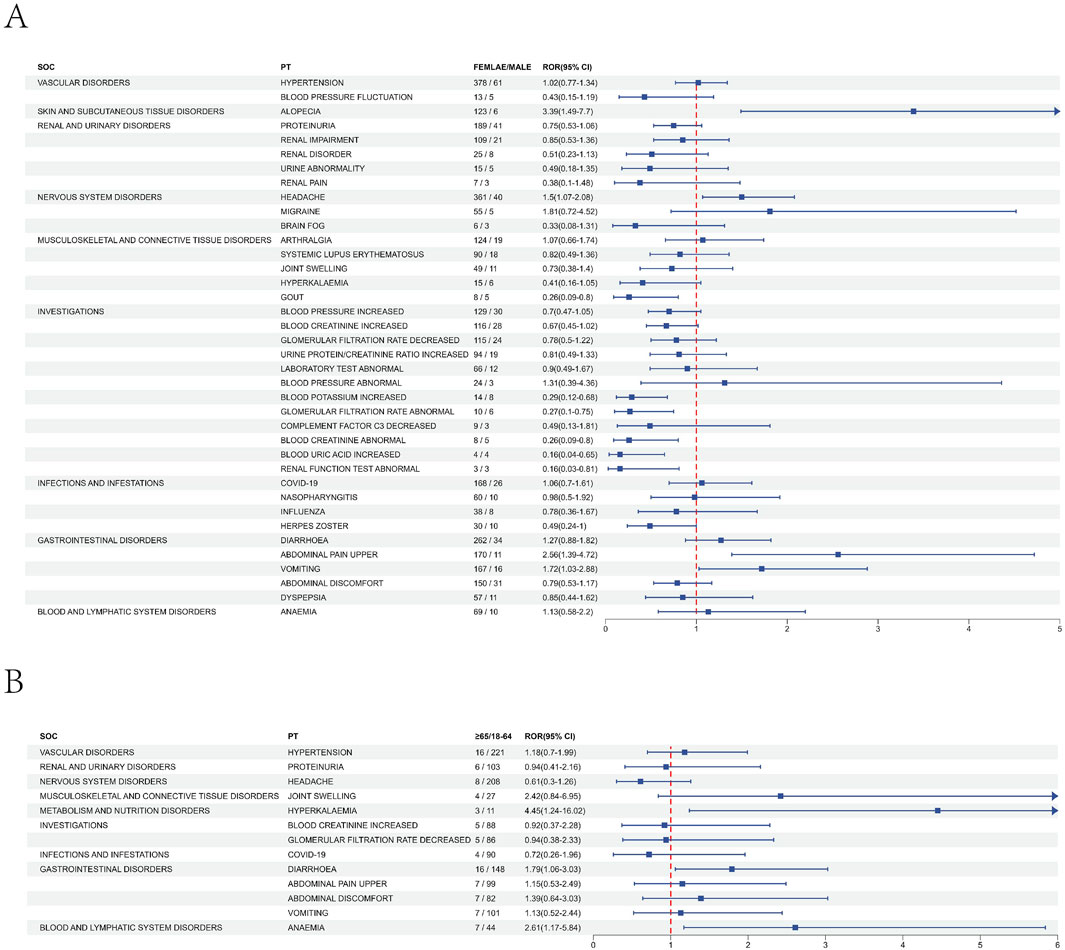
Figure 2. Subgroup analysis results of voclosporin adverse events. (A) Analysis results of the gender subgroup. (B) Analysis results of the age subgroup.
We also assessed the risk differences of safety signals between adults (aged 18–64) and the elderly (aged 65 and above). Within the 18–64 age group, we identified 96 AEs (Supplementary Table S5), whereas in the group aged 65 and above, we identified 15 AEs (Supplementary Table S6). Among individuals aged 18–64, the most frequently reported top five AEs were nausea, urine protein/creatinine ratio increased, dizziness, arthralgia, and renal impairment. In contrast, AEs exclusive to those aged 65 and above included joint swelling, arthritis, fluid retention, memory impairment, hyperkalaemia, white blood cell count decreased, and dry mouth. Further analysis revealed that among the 11 shared positive PT signals in both age subgroups, patients aged 65 and above had a higher relative risk for hyperkalaemia and anaemia compared to those aged 18–64 (Figure 2B).
Onset time of events
We analyzed 1,797 case reports of voclosporin-related AEs with known onset times. The median initiation period stood at 99 days (IQR 20–250). Nearly one-third of the AEs (n = 536, 29.8%) occurred within the first month of initiating voclosporin. Furthermore, 17.9% of AEs were reported between 180 and 360 days, and 16.4% occurred after 360 days (Figure 3A). Further analysis at the primary SOC level showed significant differences in the onset times of AEs among various SOCs (p < 0.01). In the reports of “renal and urinary disorders” and “infections and infestations,” the median onset times of adverse events were 133 days (IQR 56–335.3) and 130.5 days (IQR 48–294.3), respectively, which were significantly later than the median times for “gastrointestinal disorders” (median time 54 days, IQR 6–147) and “nervous system disorders” (median time 33 days, IQR 5–128.5) (Figure 3B). For clarity on the onset time of individual PTs in the SOC, we analyzed and compared the detailed onset times of AEs at the PT level according to the SOC. The Kruskal-Wallis test revealed statistically significant differences in the onset times of PT within “investigations” (P < 0.001) (Figure 3C). Specifically, the median onset time for blood pressure increased was the shortest (28, IQR 6–156.5), while that for increased urinary protein/creatinine ratio was the longest (251, IQR 109–550) (Supplementary Table S7). Ultimately, the Weibull parameter test results indicated that the onset times of adverse events in the “renal and urinary disorders” and “surgical and medical procedures” exhibited characteristics of a random failure type, while other SOCs showed an early failure type (Figure 3D).
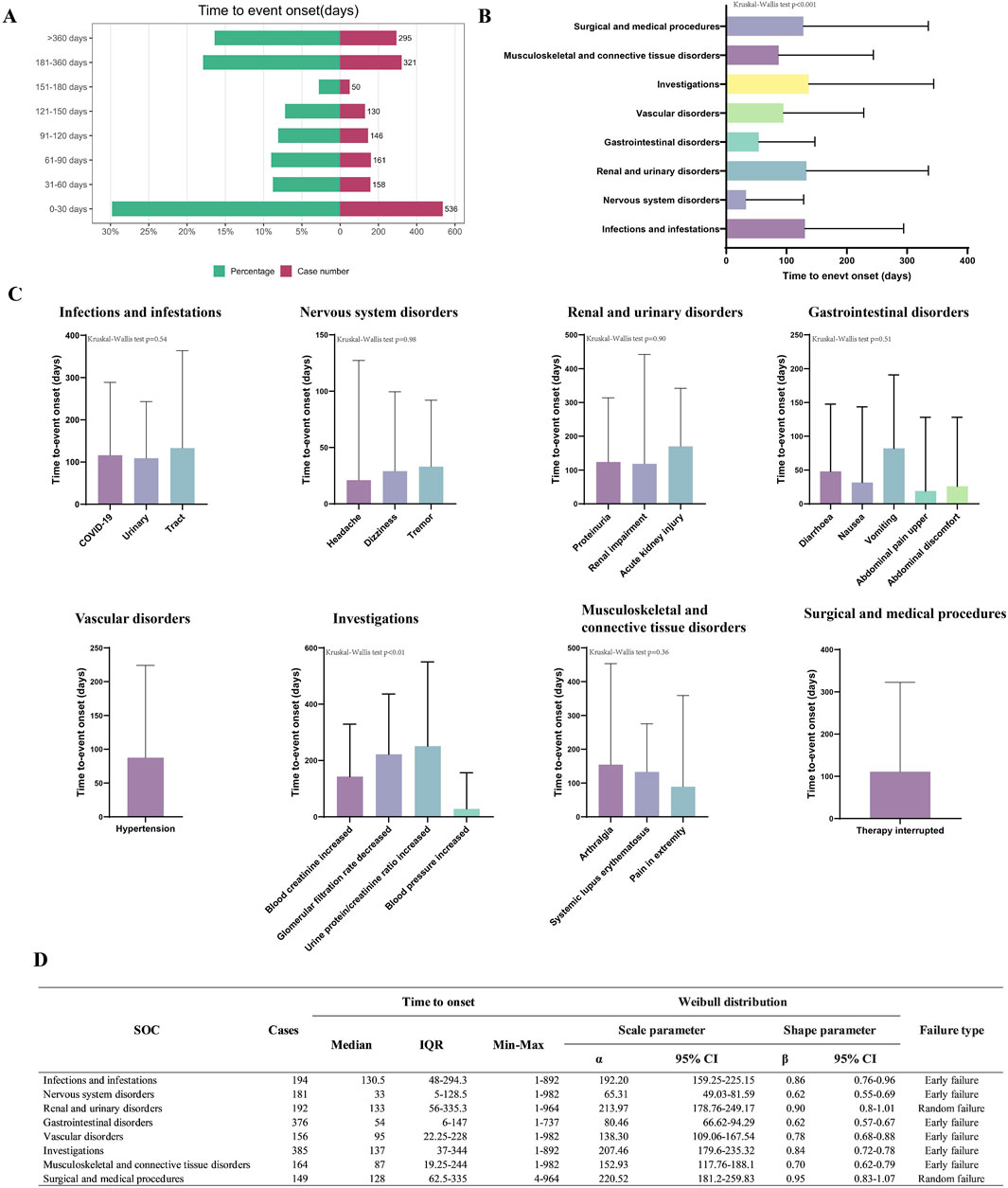
Figure 3. Analysis results of voclosporin-related adverse event onset times. (A) Overall time distribution of adverse event onset times. (B) Median time comparison at the SOC Level. (C) Median time comparison at the PT Level. (D) Summary of onset times at the SOC Level.
Discussion
At present, comprehensive real-world, large-sample safety studies on voclosporin are limited, with the majority of PubMed research focusing on small-scale, single-population studies. This study represented the first systematic pharmacovigilance research using the FAERS database on the safety of voclosporin following its market introduction.
Baseline data description
Our study indicated that the proportion of AEs was higher in females (84%) compared to males (14.8%) and a higher proportion aged between 18 and 44 years (26.4%). This finding aligns with epidemiological studies on LN, which reported that the prevalence of LN in females is approximately three to four times that in males, with a median age at diagnosis of about 38.4 years (Hocaoǧlu et al., 2023; Feldman et al., 2013). Notably, only 20% of reports contained clear outcome data, potentially due to a significant number of reports being submitted by consumers, which may have led to underreporting of outcome information. This highlights the need for increased vigilance among clinicians and pharmacists regarding voclosporin-related AEs. In addition, among the available outcome reports, more than 50% indicated serious adverse events (hospitalization, death, disability). Although this may be attributed to the severity or progression of the underlying condition, it still warrants attention from clinicians. Regarding reporting by country, the number of AEs in the United States significantly surpassed those in other countries, likely due to the earlier availability and higher prescription volume of the drug in the country. Given that the mechanisms and effectiveness of therapeutic interventions for LN vary among racial and ethnic subgroups (Isenberg et al., 2010), our analytical findings might differ in other regions. Thus, studies across different ethnicities and regions are required to validate our findings.
Risk of renal toxicity
Voclosporin is the first oral agent approved for the treatment of LN that was developed through structural modification of CsA. Like CsA, voclosporin inhibits T-cell activation by suppressing calcineurin. However, structural modification endows voclosporin with stronger immunosuppressive effects (Kuglstatter et al., 2011), which has been confirmed in vivo using a 32P-labelled calcineurin activity assay (Stalder et al., 2003). When compared to another CNI, tacrolimus, voclosporin also demonstrated comparable immunosuppressive efficacy in preventing renal transplant rejection (Anglade et al., 2008). Although voclosporin is associated with a lower metabolite burden associated with nephrotoxicity compared to CsA (Roby and Shaw, 1993; Ling et al., 2014), the AEs remain inevitable. In our study, we observed a substantial number of nephrotoxicity-related AEs, such as blood creatinine increased (n = 148, ROR = 13.79), eGFR reduced (n = 143, ROR = 57.83), and acute kidney injury (n = 54, ROR = 1.4). Therefore, during voclosporin treatment, regular monitoring of renal function is necessary to adjust the dosage based on the eGFR.
Risk of hypertension
Hypertension is common in patients treated with voclosporin. Integrated analysis of published AURA-LV and AURORA 1 trials revealed that up to 19.1% of LN patients receiving voclosporin experienced hypertension (Arriens et al., 2023). This finding corroborated our study, where hypertension (n = 442, ROR = 12.02) was the most frequently reported AE. Hypertension is also a relatively common AE among other CNI. The underlying mechanisms are believed to include activation of the renin-angiotensin system and the sympathetic nervous system, induction of oxidative stress, and alteration of the nitric oxide (NO) signaling pathway, leading to systemic vasoconstriction and elevated blood pressure (Hošková et al., 2017). Blood pressure abnormalities during voclosporin treatment are generally transient, and no patients had treatment discontinued due to hypertension (Arriens et al., 2023). Nevertheless, monitoring blood pressure remains necessary during treatment. Some calcium channel blockers (verapamil and diltiazem) may increase voclosporin blood concentrations (Ling et al., 2014), necessitating a reduction in the dose of voclosporin. If elevated blood pressure is not controlled by a reduction in voclosporin dosage alone, further medical interventions may be required. Besides hypertension, diabetes is also one of the classically CNI-attributed complications. In our study, no positive AEs related to diabetes were observed, and several other studies also proved the superiority of voclosporin in this regard (Rovin et al., 2019; Rovin et al., 2021; Kolic et al., 2020; Busque et al., 2011). Voclosporin has a milder impact on pancreatic islet function compared to other CNIs, which address the clinical needs of diabetes patients for CNI therapy.
Risk of infections and malignancies
Voclosporin’s prescribing information contains a black box warning about the increased risk of serious infection and malignancies, potentially leading to hospitalization or death, which is one of the unavoidable side effects of immunosuppressants (Chua et al., 2020). In the AURA-LV and AURORA 1 randomized controlled trials, infections were the most common AEs in both the voclosporin group and the placebo group, with 40 cases (15%) and 30 cases (11.3%) of patients considered treatment-related. Infection was also considered as the positive signal in our study, including COVID-19 (n = 196, ROR = 2.56) and urinary tract infection (n = 82, ROR = 2.47). Malignancies did not meet the positive criteria for this study. Patients treated with immunomodulatory agents are generally at an increased risk of developing malignant tumors (Munagala and Phancao, 2022; Prakash et al., 2002), with risk factors including male gender and advanced age (Ilham et al., 2023; Pendón-Ruiz de Mier et al., 2015). However, these factors differ from the epidemiological characteristics of LN (). Moreover, the relatively short time since the market introduction may also explain the negative signal for malignant tumors observed in this study. Notably, multiple studies have pointed out that compared to other immunosuppressants, CNIs were associated more with the development of malignancies (Pendón-Ruiz de Mier et al., 2015; Doesch et al., 2010; Kulbat et al., 2023). Therefore, it is recommended that healthcare professionals continue vigilant monitoring for malignant AEs during the clinical use of voclosporin.
Adverse events related to primary disease
In our study, positive SOC signals related to the primary disease were also reported, including “musculoskeletal and connective tissue disorders” and “investigations.” LN is secondary to SLE. The numerous positive AEs observed in this study, such as arthralgia (n = 143, ROR = 1.69), pain in extremity (n = 71, ROR = 1.39), malar rash (n = 109, ROR = 13.24), and proteinuria detection (n = 33, ROR = 33.08), represented the different organ manifestations of SLE (Kiriakidou and Ching, 2020). Given that 80% of the reports in this study were submitted by consumers, we have reason to believe that, although LN is not a rare disease, it remains poorly understood. This highlights the necessity for patients on voclosporin to be well-informed about the manifestations of LN progression and to distinguish them from drug adverse reactions.
Adverse events at other SOC level
Among the SOC of nervous system disorders, a large number of AEs were also reported, such as headaches (n = 404, ROR = 3.79), dizziness (n = 129, ROR = 1.59), and migraine (n = 60, ROR = 3.25). This could be attributable to the neurotoxicity of CNIs (Faravelli et al., 2021), as described in the product instructions. Previous studies found that the incidence of gastrointestinal-related AEs was higher in the treatment group compared with the placebo group (Rovin et al., 2021). In our study, gastrointestinal-related AEs (n = 1737, ROR = 2.03) notably exceeded expectations and represented the highest number of AEs across all SOC. Common AEs included nausea (n = 342, ROR = 2.62), diarrhea (n = 297, ROR = 2.4), and vomiting (n = 185, ROR = 2.42). Although not being explicitly detailed in the product instruction, it is necessary for physicians to inform patients about the potential risk of gastrointestinal-related AEs. Additionally, our findings revealed some rare and unexpected AEs including breath odor (n = 4, ROR = 12.5), gastroesophageal reflux disease (n = 23, ROR = 1.73), menstrual disorder (n = 7, ROR = 5.82), vision blurred (n = 32, ROR = 1.5), insomnia (n = 61, ROR = 1.46), and acute pulmonary oedema (n = 3, ROR = 4.16). These adverse reactions require further research to elucidate their specific mechanisms of occurrence.
Gender and age differences in adverse events
Gender differences have been shown to influence drug bioavailability, distribution, metabolism, and elimination (Zopf et al., 2009), leading to disparities in ADEs between males and females. However, there is a lack of reports on gender-specific ADEs associated with voclosporin treatment. In our study, we observed a greater number of positive signal values for ADEs in females compared to males. Alopecia, headache, upper abdominal pain, and vomiting exhibited a stronger correlation with females, while gout, abnormal serum creatinine levels, increased serum uric acid, and abnormal renal function tests demonstrated a stronger correlation with males. Some of these adverse reactions are inherently gender-specific; for example, the incidence of headache was higher in females than in males (Silberstein, 2000). Serum uric acid levels tend to increase steadily in males before the age of 50, while levels remain stable in females (Zitt et al., 2020). This might have been the reason why the uric acid metabolism in males was more susceptible to the effects of medications. In the age subgroup analysis, we found that older adults had a higher relative risk of hyperkalemia and anemia compared to younger adults. Hyperkalemia is a common electrolyte disturbance induced by CNIs, which can lead to life-threatening arrhythmias. This ionic disturbance is more challenging to regulate due to the presence of underlying kidney disease in patients. A strong positive correlation exists between the severity of hyperkalemia and mortality risk (Sun et al., 2024), making early identification and treatment of hyperkalemia crucial. Healthcare providers need to implement interventions to enhance patient awareness of hyperkalemia. In summary, our findings provide insights into population-specific side effects. While these findings require further validation, they offer improved guidance for drug monitoring in diverse populations.
Time to onset of adverse events
In this study, 31.35% of AEs associated with voclosporin occurred within the first month of treatment, notably gastrointestinal and neurological AEs; the total number of AEs decreased monthly thereafter. At the specific SOC level, the median reporting times for renal and infectious AEs were observed to be later. In summary, clinical monitoring strategies should continue to be optimized, with a particular emphasis on the early detection and management, especially during the first month of voclosporin treatment. Furthermore, heightened vigilance is required for renal and infectious adverse reactions during prolonged therapy.
Limitations
This study was subject to several limitations. Firstly, the FAERS database is an open, voluntary reporting system. The AE information might be delayed, incomplete, and inaccurate due to the different reporters (professionals and non-professionals). For example, 60.5% of the reports in this study did not provide age information and 80.7% did not provide treatment outcomes. Second, voclosporin often combines with other immunosuppressive drugs. The FDA analyzes all collected adverse drug events, which may confound some adverse reactions, as they might be the result of combination therapy or different treatment strategies. Moreover, our research could only provide a statistical association between voclosporin and AEs, the true incidence of each AE could not be calculated due to the absence of data on the total number of cases occurring in the population. Therefore, while the research provides valuable insights, further investigation is still required to get a comprehensive understanding of the risk associated with voclosporin use.
Conclusion
The present study conducted a comprehensive pharmacovigilance analysis of voclosporin based on the FAERS database. Our study has unearthed numerous voclosporin safety signals consistent with clinical trials, such as “renal and urinary disorders” and “infections and infestations.” Notably, the number of gastrointestinal disease-related AEs reported exceeded expectations and were not mentioned in the product instruction, necessitating further evaluation. These findings provided valuable insights into the safety profiles of voclosporin in real-world practice.
Data availability statement
The original contributions presented in the study are included in the article/Supplementary Material, further inquiries can be directed to the corresponding author.
Author contributions
ZW: Conceptualization, Writing – original draft. YL: Validation, Visualization, Writing – review and editing. XL: Formal Analysis, Writing – original draft. YW: Writing – original draft. LS: Writing – review and editing.
Funding
The author(s) declare that financial support was received for the research and/or publication of this article. This study was supported by grants from the National Natural Science Foundation of China (No. 821707171).
Acknowledgments
This study was performed using the FDA Adverse Event Reporting System (FAERS) database that was provided by the FDA. The information, the results, or interpretation of the current study do not represent any opinion of the FDA.
Conflict of interest
The authors declare that the research was conducted in the absence of any commercial or financial relationships that could be construed as a potential conflict of interest.
Generative AI statement
The author(s) declare that no Generative AI was used in the creation of this manuscript.
Publisher’s note
All claims expressed in this article are solely those of the authors and do not necessarily represent those of their affiliated organizations, or those of the publisher, the editors and the reviewers. Any product that may be evaluated in this article, or claim that may be made by its manufacturer, is not guaranteed or endorsed by the publisher.
Supplementary material
The Supplementary Material for this article can be found online at: https://www.frontiersin.org/articles/10.3389/fphar.2025.1506760/full#supplementary-material
References
Anders, H. J., Saxena, R., Zhao, M. H., Parodis, I., Salmon, J. E., and Mohan, C. (2020). Lupus nephritis. Nat. Rev. Dis. Prim. 6 (1), 7. doi:10.1038/s41572-019-0141-9
Anglade, E., Aspeslet, L. J., and Weiss, S. L. (2008). A new agent for the treatment of noninfectious uveitis: rationale and design of three LUMINATE (Lux Uveitis Multicenter Investigation of a New Approach to Treatment) trials of steroid-sparing voclosporin. Clin. Ophthalmol. 2 (4), 693–702. doi:10.2147/opth.s2452
Arriens, C., Teng, Y. K. O., Ginzler, E. M., Parikh, S. V., Askanase, A. D., Saxena, A., et al. (2023). Update on the efficacy and safety profile of voclosporin: an integrated analysis of clinical trials in lupus nephritis. Arthritis Care Res. Hob. 75 (7), 1399–1408. doi:10.1002/acr.25007
Bihan, K., Lebrun-Vignes, B., Funck-Brentano, C., and Salem, J. E. (2020). Uses of pharmacovigilance databases: an overview. Therapie 75 (6), 591–598. doi:10.1016/j.therap.2020.02.022
Busque, S., Cantarovich, M., Mulgaonkar, S., Gaston, R., Gaber, A. O., Mayo, P. R., et al. (2011). The PROMISE study: a phase 2b multicenter study of voclosporin (ISA247) versus tacrolimus in de novo kidney transplantation. Am. J. Transpl. 11 (12), 2675–2684. doi:10.1111/j.1600-6143.2011.03763.x
Chua, A. W., Chua, M. J., Harrisberg, B. P., and Kumar, C. M. (2020). Review of anaesthetic management for cataract surgery in transplant recipients. Anaesth. Intensive Care 48 (1), 25–35. doi:10.1177/0310057X19891737
Croca, S. C., Rodrigues, T., and Isenberg, D. A. (2011). Assessment of a lupus nephritis cohort over a 30-year period. Rheumatol. Oxf. 50 (8), 1424–1430. doi:10.1093/rheumatology/ker101
Doesch, A. O., Müller, S., Konstandin, M., Celik, S., Kristen, A., Frankenstein, L., et al. (2010). Malignancies after heart transplantation: incidence, risk factors, and effects of calcineurin inhibitor withdrawal. Transpl. Proc. 42 (9), 3694–3699. doi:10.1016/j.transproceed.2010.07.107
Faravelli, I., Velardo, D., Podestà, M. A., and Ponticelli, C. (2021). Immunosuppression-related neurological disorders in kidney transplantation. J. Nephrol. 34 (2), 539–555. doi:10.1007/s40620-020-00956-1
Feldman, C. H., Hiraki, L. T., Liu, J., Fischer, M. A., Solomon, D. H., Alarcón, G. S., et al. (2013). Epidemiology and sociodemographics of systemic lupus erythematosus and lupus nephritis among US adults with Medicaid coverage, 2000-2004. Arthritis Rheum. 65 (3), 753–763. doi:10.1002/art.37795
Hocaoǧlu, M., Valenzuela-Almada, M. O., Dabit, J. Y., Osei-Onomah, S. A., Chevet, B., Giblon, R. E., et al. (2023). Incidence, prevalence, and mortality of lupus nephritis: a population-based study over four decades using the lupus midwest network. Arthritis Rheumatol. 75 (4), 567–573. doi:10.1002/art.42375
Hošková, L., Málek, I., Kopkan, L., and Kautzner, J. (2017). Pathophysiological mechanisms of calcineurin inhibitor-induced nephrotoxicity and arterial hypertension. Physiol. Res. 66 (2), 167–180. doi:10.33549/physiolres.933332
Ilham, S., Willis, C., Kim, K., Chung, K. C., Wood, B. M., Tan, M. S., et al. (2023). Cancer incidence in immunocompromised patients: a single-center cohort study. BMC Cancer 23 (1), 33. doi:10.1186/s12885-022-10497-4
Isenberg, D., Appel, G. B., Contreras, G., Dooley, M. A., Ginzler, E. M., Jayne, D., et al. (2010). Influence of race/ethnicity on response to lupus nephritis treatment: the ALMS study. Rheumatol. Oxf. 49 (1), 128–140. doi:10.1093/rheumatology/kep346
Kale, A., Shelke, V., Lei, Y., Gaikwad, A. B., and Anders, H. J. (2023). Voclosporin: unique chemistry, pharmacology and toxicity profile, and possible options for implementation into the management of lupus nephritis. Cells 12 (20), 2440. doi:10.3390/cells12202440
Kiriakidou, M., and Ching, C. L. (2020). Systemic lupus erythematosus. Ann. Intern Med. 172 (11), ITC81–ITC96. doi:10.7326/AITC202006020
Kolic, J., Beet, L., Overby, P., Cen, H. H., Panzhinskiy, E., Ure, D. R., et al. (2020). Differential effects of voclosporin and tacrolimus on insulin secretion from human islets. Endocrinology 161 (11), bqaa162. doi:10.1210/endocr/bqaa162
Kuglstatter, A., Mueller, F., Kusznir, E., Gsell, B., Stihle, M., Thoma, R., et al. (2011). Structural basis for the cyclophilin A binding affinity and immunosuppressive potency of E-ISA247 (voclosporin). Acta Crystallogr. D. Biol. Crystallogr. 67 (Pt 2), 119–123. doi:10.1107/S0907444910051905
Kulbat, A., Richter, K., Stefura, T., Kołodziej-Rzepa, M., Kisielewski, M., Wojewoda, T., et al. (2023). Systematic review of calcineurin inhibitors and incidence of skin malignancies after kidney transplantation in adult patients: a study of 309,551 cases. Curr. Oncol. 30 (6), 5727–5737. doi:10.3390/curroncol30060430
Lech, M., and Anders, H. J. (2013). The pathogenesis of lupus nephritis. J. Am. Soc. Nephrol. 24 (9), 1357–1366. doi:10.1681/ASN.2013010026
Ling, S. Y., Huizinga, R. B., Mayo, P. R., Larouche, R., Freitag, D. G., Aspeslet, L. J., et al. (2014). Cytochrome P450 3A and P-glycoprotein drug-drug interactions with voclosporin. Br. J. Clin. Pharmacol. 77 (6), 1039–1050. doi:10.1111/bcp.12309
Lupkynis (2021). Voclosporin [prescribing information]. Available online at: https://www.accessdata.fda.gov/drugsatfda_docs/label/2021/213716s000lbl.pdf.
Moroni, G., Vercelloni, P. G., Quaglini, S., Gatto, M., Gianfreda, D., Sacchi, L., et al. (2018). Changing patterns in clinical-histological presentation and renal outcome over the last five decades in a cohort of 499 patients with lupus nephritis. Ann. Rheum. Dis. 77 (9), 1318–1325. doi:10.1136/annrheumdis-2017-212732
Munagala, M., and Phancao, A. (2022). Malignancy: an adverse effect of immunosuppression. Handb. Exp. Pharmacol. 272, 315–335. doi:10.1007/164_2021_554
Obrişcă, B., Sorohan, B., Tuță, L., and Ismail, G. (2021a). Advances in lupus nephritis pathogenesis: from bench to bedside. Int. J. Mol. Sci. 22 (7), 3766. doi:10.3390/ijms22073766
Obrişcă, B., Vornicu, A., Jurubiță, R., Achim, C., Bobeică, R., Andronesi, A., et al. (2021b). Corticosteroids are the major contributors to the risk for serious infections in autoimmune disorders with severe renal involvement. Clin. Rheumatol. 40 (8), 3285–3297. doi:10.1007/s10067-021-05646-2
Pendón-Ruiz de Mier, V., Navarro Cabello, M. D., Martínez Vaquera, S., Lopez-Andreu, M., Aguera Morales, M. L., Rodriguez-Benot, A., et al. (2015). Incidence and long-term prognosis of cancer after kidney transplantation. Transpl. Proc. 47 (9), 2618–2621. doi:10.1016/j.transproceed.2015.08.043
Prakash, O., Gill, J., and Farr, G. (2002). Immune disorders and susceptibility to neoplasms. Ochsner J. 4 (2), 107–111.
Rafael-Vidal, C., Altabás, I., Pérez, N., Mourino Rodríguez, C., Pego-Reigosa, J. M., and Garcia, S. (2021). Calcineurin and systemic lupus erythematosus: the rationale for using calcineurin inhibitors in the treatment of lupus nephritis. Int. J. Mol. Sci. 22 (3), 1263. doi:10.3390/ijms22031263
Roby, K. A., and Shaw, L. M. (1993). Effects of cyclosporine and its metabolites in the isolated perfused rat kidney. J. Am. Soc. Nephrol. 4 (2), 168–177. doi:10.1681/ASN.V42168
Rovin, B. H., Solomons, N., Pendergraft, W. F., Dooley, M. A., Tumlin, J., Romero-Diaz, J., et al. (2019). A randomized, controlled double-blind study comparing the efficacy and safety of dose-ranging voclosporin with placebo in achieving remission in patients with active lupus nephritis. Kidney Int. 95 (1), 219–231. doi:10.1016/j.kint.2018.08.025
Rovin, B. H., Teng, Y. K. O., Ginzler, E. M., Arriens, C., Caster, D. J., Romero-Diaz, J., et al. (2021). Efficacy and safety of voclosporin versus placebo for lupus nephritis (AURORA 1): a double-blind, randomised, multicentre, placebo-controlled, phase 3 trial. Lancet 397 (10289), 2070–2080. doi:10.1016/S0140-6736(21)00578-X
Silberstein, S. D. (2000). Sex hormones and headache. Rev. Neurol. Paris. 156 (Suppl. 4), 4S30–4S41.
Stalder, M., Bîrsan, T., Hubble, R. W., Paniagua, R. T., and Morris, R. E. (2003). In vivo evaluation of the novel calcineurin inhibitor ISATX247 in non-human primates. J. Heart Lung Transpl. 22 (12), 1343–1352. doi:10.1016/s1053-2498(03)00033-0
Sun, J., Liu, Q., Seery, S., Sun, L., Yuan, Y., Wang, W., et al. (2024). The impact of hyperkalemia on ICU admission and mortality: a retrospective study of Chinese emergency department data. BMC Emerg. Med. 24 (1), 95. doi:10.1186/s12873-024-01011-z
Yung, S., Yap, D. Y., and Chan, T. M. (2020). A review of advances in the understanding of lupus nephritis pathogenesis as a basis for emerging therapies. F1000Res 9, 905. doi:10.12688/f1000research.22438.1
Zhou, Y., Xiao, L., and Tang, S. (2018). Annexin A2 and FTH1 are potential biomarkers for lupus nephritis. Exp. Ther. Med. 16 (5), 3766–3776. doi:10.3892/etm.2018.6686
Zitt, E., Fischer, A., Lhotta, K., Concin, H., and Nagel, G. (2020). Sex- and age-specific variations, temporal trends and metabolic determinants of serum uric acid concentrations in a large population-based Austrian cohort. Sci. Rep. 10 (1), 7578. doi:10.1038/s41598-020-64587-z
Zopf, Y., Rabe, C., Neubert, A., Janson, C., Brune, K., Hahn, E. G., et al. (2009). Gender-based differences in drug prescription: relation to adverse drug reactions. Pharmacology 84 (6), 333–339. doi:10.1159/000248311
Keywords: voclosporin, lupus nephritis, pharmacovigilance, disproportionality analysis, FAERS database
Citation: Wang Z, Lang Y, Liu X, Wang Y and Shao L (2025) Post-marketing safety surveillance of voclosporin: an observational, pharmacovigilance study leveraging faers database study on the safety of voclosporin. Front. Pharmacol. 16:1506760. doi: 10.3389/fphar.2025.1506760
Received: 06 October 2024; Accepted: 05 May 2025;
Published: 19 May 2025.
Edited by:
Giovanni Luca Romano, Kore University of Enna, ItalyReviewed by:
Ziran Li, University of California, San Francisco, United StatesChiara Pennisi, Kore University of Enna, Italy
Copyright © 2025 Wang, Lang, Liu, Wang and Shao. This is an open-access article distributed under the terms of the Creative Commons Attribution License (CC BY). The use, distribution or reproduction in other forums is permitted, provided the original author(s) and the copyright owner(s) are credited and that the original publication in this journal is cited, in accordance with accepted academic practice. No use, distribution or reproduction is permitted which does not comply with these terms.
*Correspondence: Leping Shao, bGVwaW5nc2hhb0AxNjMuY29t
†These authors have contributed equally to this work and share first authorship
 Zhi Wang
Zhi Wang Yanhua Lang2†
Yanhua Lang2† Xuyan Liu
Xuyan Liu Leping Shao
Leping Shao